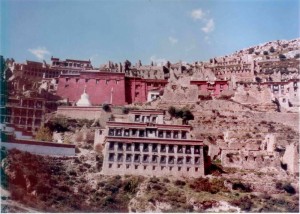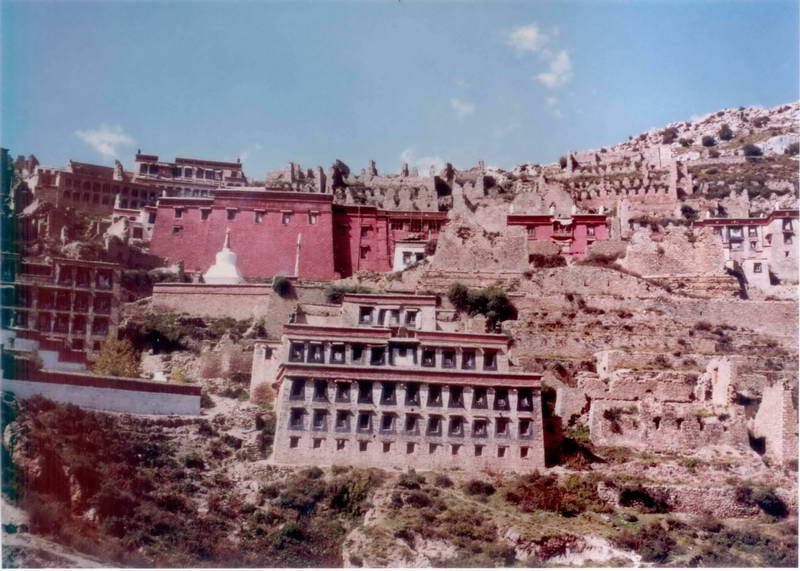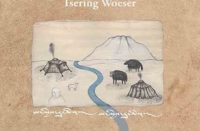High Peaks Pure Earth has translated a blogpost by Woeser written on June 15, 2011 for the Tibetan service of Radio Free Asia and posted on her blog on July 13, 2011.
In this blogpost Woeser continues her ruminations on Ganden Monastery, originally started in the article posted earlier online titled: “Who is Responsible for the Destruction of Ganden Monastery?”

After the Cultural Revolution, China’s policies towards Tibet changed; after 1979, His Holiness the Dalai Lama sent three delegations of representatives (the Chinese refer to them as “visitors”) to return to Tibet and investigate the situation.
The following story really reveals the emotions related to the vicissitudes of human life. Every time I read the records of those visits, every time I watch related scenes in documentaries, I start shedding tears of sorrow. One of these reports mentions Ganden Monastery; it was from a third visit of a delegation that went to Lhasa in 1980, which reads as follows: “In the past, over one hundred grand buildings were towering here but now there is nothing left except for long rows of broken walls. Ganden Monastery has more or less been blown to ruins. Tenzin Tethong said: ‘We had heard about the destruction of Ganden Monastery before we came but the scenes we witnessed are beyond all description… it looks as if the monastery were ruined over five hundred years ago, instead of just twenty.'”
Not only returnees feel sad about this but also, or even more so, those who live and grew up in the area. Tenzin Tethong says: “When we arrived, people were simply unable to suppress their feelings. Everyone rushed down from the mountains, crying and screaming… pointing at the mountain and saying ‘Look, this is our Ganden Monastery, come and see how they have destroyed it!'”
In fact, the people who the exiled Tibetans encountered were devotees who had spontaneously organised themselves to restore Ganden Monastery. But it was not only Ganden Monastery, after the Cultural Revolution, many groups who started engaging in restoration work on monasteries burgeoned everywhere in Tibet. Only on one point do I slightly disagree. I think that one should restore other monasteries but not Ganden Monastery, because Ganden Monastery in ruins serves as a true Cultural Revolution memorial site for the people. Many affected monasteries now show slogans from the Cultural Revolution or traces of Mao Zedong’s quotations or portraits; the past is the past, revisiting it is humiliating. I understand that the monastic community and lay people want to paint over those mutilations but I think one should still keep them.
Let’s think about it, no matter whether devotees, visitors, or armed police carrying weapons, they will all see the stretches of broken and ruined wall covering the mountain, the once dense forest, which has long thinned out, and they will hear the twittering of the birds who seem to be telling people what once happened in this place. This resembles a train station in Germany where Jews were transported into concentration camps; today, we find no train, all that is left are the numbers and dates of when Jews were transported away. An historian states, “This is the most effective way of commemorating, it is not about erecting some kind of memorial sign, it is about leaving a space that has no function, this goes far beyond any kind of restoration or replacement. Here, history is not being moved into museums, it is exposed to any wind and weather.”
Indeed, any wind and weather will even slowly dissolve the broken walls but I nevertheless believe that ruins can never be replaced by any kind of restoration or refurbishment. Those who think that in order to prove that Ganden Monastery has always existed, one has to recover the old architecture to make it look like it used, are showing a kind of stubbornness with regards to the essence of reality.
From the point of view of Buddhist teachings, ruins are the same as death, the vicissitude of life is the most distinct lesson human beings have been taught. From an aesthetic point of view, the devastated ruins are far more beautiful than a brand new, richly ornamented building. At least, even if Ganden Monastery has to be refurbished, one could only restore the central Buddhist Hall and the stupa that used to have the doctrines of Tsongkhapa hidden inside. With regards to the surrounding ruins, there is no need to restore them to their original state. In this way, all the funds can be invested in restoring the just mentioned important parts and will make those look as before or perhaps even more splendid than before. Moreover, having the splendour and the ruins exist at the same time and next to each other will create a shocking memorial site that Tibet has never had before.
Tibet does need this kind of memorial hall!
June 15, 2011





Thought provoking Woesser la. I was very fortunate to be able to visit when Gaden was still in ruins except for the lone red temple in the midst of the ruins. It shook me so hard.
This is such a contentious issue, the rebuilding of destroyed monasteries. Even in the last 2 years travelling through Kham and Amdo, I have seen monastic ruins of buildings from Cultural Revolution fully knocked down and built over with modern concrete structures. When I ask local monks about their big new Temple they're building they say the Govt fuly supported rebuilding their monasteries and knocking down the ruins. On one level I understand their desire to build up their monasteries to former glory and beauty but at the same time I think "Well of course the govt will support this, they don't want people to see what was done in the past, the truth of history has no place in the present PRC."
It feels like Tibetan are being duped all over again on the issue. Many have no conception of the value of the remnants of these ancient structures, "They're ugly, they make us feel sad", they say, fair point I guess.
When your own nation's history is completed absent from your education how can you be expected to value the past.
Woeser la, Do you have any idea of Pemakoe,and do you know why pemakoepas are not able to come to india like other Tibetan what is the reason ?